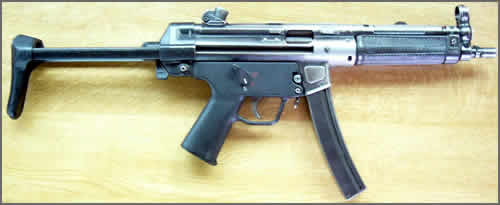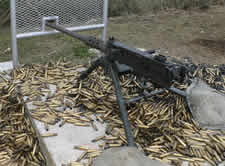Home | Glossary | Resources | Help | Contact Us | Course Map
Archival Notice
This is an archive page that is no longer being updated. It may contain outdated information and links may no longer function as originally intended.
Semiautomatic and Automatic
Recoil Operated
Once repeating operation had been achieved, designers sought ways to automate the action; pulling the trigger should be all that is required. Designers knew that chemical energy was already available in the cartridge for faster operation of the firearm. Firearms recoil or kick due to classic physics: for every action there is an equal and opposite reaction. Recoil energy can be redirected to operate the firearm.
Semiautomatic and full automatic fire are similar in operation; many semiautomatic designs can be adapted to full automatic capability by military arsenals.
The first inventor credited with using recoil to operate a gun action was Hiram Maxim. Between 1881 and 1883, he experimented with adding levers and springs to an existing Winchester lever-action rifle to harness recoil and cycle the action. He obtained a U.S. Patent in 1884 for a recoil-operated semiautomatic firearm. The design in Maxims patent was not for the Winchester conversion used in his experiments, but for a new design. It incorporated a fully locked breech suitable for high-power cartridges and used a long-recoil system.
For low-powered cartridges that reach peak firing pressure quickly, the bolt does not need to be locked for safe pressure control. The bolt mass and the bolt return spring are sufficient to hold the bolt closed briefly during firing. This is common in semiautomatic .22 caliber rimfire arms. Recoil and gas pressure push the bolt open, extract the spent cartridge, cock the firing mechanism, and chamber a fresh cartridge. This type of unlocked recoil-operated action is called blowback.
Some firearms require a locked breech to safely handle cartridges of greater power and longer peak pressure duration. Greater momentum is needed to unlock the bolt so the cycle can continue. This is accomplished by allowing some part of the firearm (usually the barrel) to move rearward with the cartridge. The extra mass of the added moving parts provides the additional momentum needed to unlock the action and provides a slight delay to allow cartridge pressures to fall before the action unlocks.
Depending on how far the parts move, the system is called short recoil or long recoil. When parts move less than 1/2 inch, the action is considered short-recoil (e.g., Colt Model 1911 and Luger Model 1908). When the movement of parts is nearly equal to the length of the cartridge, the term long recoil is applied (e.g., Remington Model 11 and Browning Model A5 shotguns).
Gas Operated
A discharging cartridge produces a large volume of hot gas that can be harnessed to do work. Just as burning gasoline pushes the piston of an internal combustion engine, expanding gas from a cartridge can be used to drive a piston attached to the repeating mechanism.
In gas operation, gas from the barrel is redirected 180 degrees to do work in the direction of the repeating mechanism. The gas may push on an internal piston (U.S. M1 Garand) or an external ring (Remington Model 1100 shotgun).
The vast majority of gas-operated firearms have ported barrels to bleed off the gas. The size of the ports depends on the following factors:
- The position down the barrel
- The operating pressure of the cartridge
- The rate of pressure decrease as the bullet moves through the barrel
The actual gas piston can use either a short or long stroke. The gas enters a small chamber under the barrel; one wall of the chamber is the piston. The piston moves rapidly rearward and impacts the end of the rod attached to the bolt. The impact unlocks the action, and the recoil of the cartridge pushes the bolt open.
Blowback
Blowback is a firearm design that directly utilizes the breech pressure exerted on the head of the cartridge case to actuate the mechanism. Blowback operation provides a high rate of fire as a balance for the commonly used, less powerful pistol cartridges.
Most submachine guns function by blowback, although a few locked breech designs exist (Heckler & Koch MP5). Many low-cost submachine guns fire from an open bolt that has a fixed firing pin, which never retracts as in other gun classes.
The firing sequence of most submachine guns occurs as follows:
- The trigger mechanism holds the cocked bolt back, usually behind a box magazine.
- Pulling the trigger releases the spring-loaded bolt, which travels forward.
- As the bolt travels, it strips the top cartridge off the magazine and feeds it into the chamber.
- As the bolt closes, the cartridge fires, driving the bolt back to repeat the cycle.
Machine Guns
True machine guns fire rifle cartridges and must have a locking system to secure the breech against pressures approaching 65,000 psi. The extra time required for locking and unlocking a machine gun often causes a somewhat slower cyclic rate of fire. Machine guns may be fed from spring-loaded box magazines, gravity feed magazines, or belts.
Summary
The most noteworthy firearms design and ammunition development occurred from the 1700s through the 1900s. Modern firearms operating systems are evolutionary products resulting from concepts developed in the late 1800s and early 1900s. Materials and manufacturing precision have improved; cartridges are more powerful and compact. The essence of good early designs remains the basis of every modern firearm.
Additional Online Courses
- What Every First Responding Officer Should Know About DNA Evidence
- Collecting DNA Evidence at Property Crime Scenes
- DNA – A Prosecutor’s Practice Notebook
- Crime Scene and DNA Basics
- Laboratory Safety Programs
- DNA Amplification
- Population Genetics and Statistics
- Non-STR DNA Markers: SNPs, Y-STRs, LCN and mtDNA
- Firearms Examiner Training
- Forensic DNA Education for Law Enforcement Decisionmakers
- What Every Investigator and Evidence Technician Should Know About DNA Evidence
- Principles of Forensic DNA for Officers of the Court
- Law 101: Legal Guide for the Forensic Expert
- Laboratory Orientation and Testing of Body Fluids and Tissues
- DNA Extraction and Quantitation
- STR Data Analysis and Interpretation
- Communication Skills, Report Writing, and Courtroom Testimony
- Español for Law Enforcement
- Amplified DNA Product Separation for Forensic Analysts




